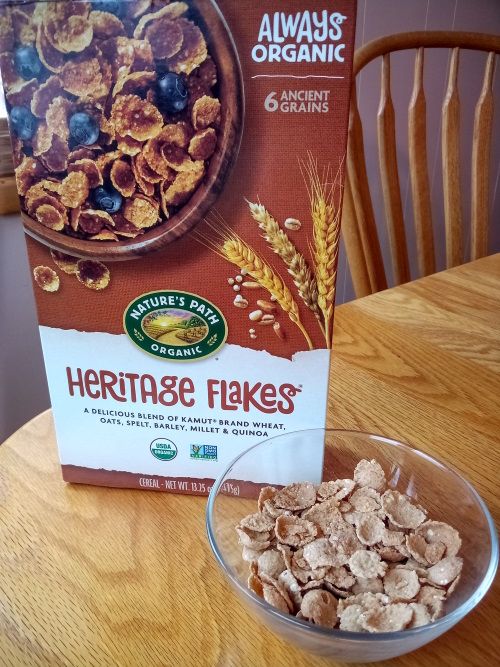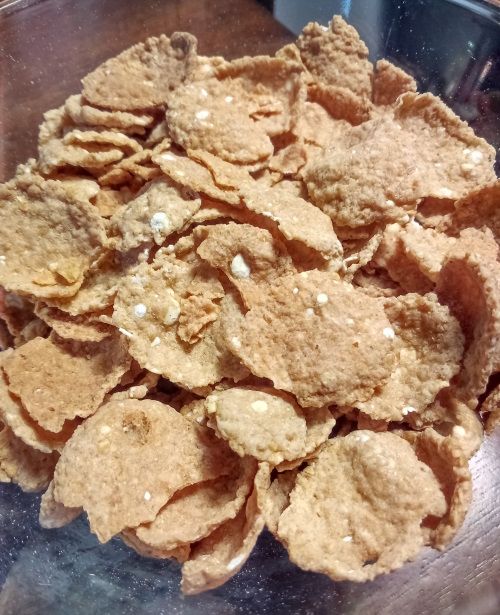It's been a while since I started eating these Heritage Flakes from Nature's Path but I do believe that it was the rather uncommon grains on the label that initially caught my attention. I think everyone is familiar with barley and oats but what's spelt? Millet? Quinoa? Kamut Khorasan wheat?
Like Kamut Khorasan, spelt is also a wheat. Common wheat, the stuff we are all familiar with, has the taxonomic name of Triticum aestivum. Spelt is Triticum spelta and Khorasan wheat Triticum turgidum. So they're all seeds of related grasses. It sounds like spelt used to be the most common variety in the European and American diets until about 100 years or so ago when, as Wikipedia puts it, "spelt was replaced by bread wheat in almost all areas where it was still grown." It doesn't say exactly why, though. Other sites posit various theories but it seems that a general difficulty in growing the stuff mixed with the need to rid the seeds of their pesky hulls led to the widespread adoption of common wheat.
This breakfast cereal has 6 grains in it and I am not sure how or how much spelt contributes to its taste. I don't recall ever having eaten something like spelt bread where its flavor would stand out. Tangentially, Vintage Brewing here in Madison offers a beer called Jinja Ninja which is brewed with spelt and described as a "spelt-based, ginger-laced amber double witbier".
Khorasan wheat - "Kamut" is a brand name - is about twice the size of common wheat and, Wikipedia says, is rather rare, as in not many acres are devoted to growing the stuff worldwide. This surely explains why I've seen the odd spelt beer here or spelt bread there but Heritage Flakes are the only product I've ever seen made with Khorasan wheat. Legend has it that its seeds were brought from Egypt to Montana after World War II and that is why we have the stuff here today. It is described as having a "rich, nutty flavor."
Unlike all of these varieties of wheat, quinoa is not a grass. It's called a "pseudocereal" because its seeds are processed like those from grasses, such as wheat. South America is home for quinoa, having been domesticated in the area around Lake Titcaca 7,000+ years ago.
Titicaca. (hee hee)
The Incas loved only potatoes more. Quinoa is easily found in grocery stores here and some restaurants serve it as part of a salad or in place of rice. I haven't eaten it untainted by something else in a while but seem to recall it having a mellow, kind of green vegetal taste.
We're back to grasses with millet, though it's unrelated to wheat. I tend to associate millet with Africa though it's also grown in parts of Asia. It doesn't require a lot of water so it's a popular crop in more arid spots. It seems to be as common as spelt around these parts. Perhaps a little less. Or just found in different foods. There are some millet products at the grocery store but not so much in restaurants, it seems to me.
I'm going to take another tangent into beer here and note that Sprecher Brewing in Milwaukee was way ahead of the curve with gluten-free beers. In 2006-2007 they introduced a couple African-style ales called Shakparo and Mbege both of which used millet. (And sorghum, I believe.) I recall enjoying both of them. Too bad Sprecher is now a soda company that makes beer on the side instead of being a brewery.
So how are these Heritage Flakes?
They are thicker than your average flakes from Kellogg's, General Mills, or any other major breakfast cereal maker. I am not sure what the white dots are. Specs of oats?
The Khorasan wheat seems to be the big daddy here as these flakes are rich and have a very pronounced nutty flavor. Lots of crunch to them as well, even after soaking in milk for a time that would wilt the heartiest of corn flakes. Just enough sugar and salt to accent the grains but not overwhelm them.
It's not clear to me just how ancient the grains and the pseudocereal here are. I mean, the grains in other cereals date back a long time too. Common wheat and corn weren't invented yesterday. So, is the spelt here more or less the same stuff my German ancestors were eating in 1200? Is the quinoa more or less equivalent to that which the denizens of Machu Picchu ate to break their fasts?
I don't know. Regardless, Heritage Flakes are tasty and offer a good flavor that just isn't found elsewhere.


No comments:
Post a Comment